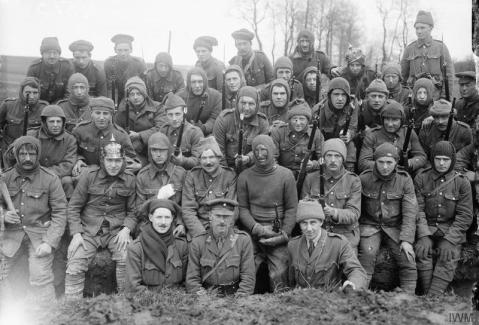Raiding Parties – What really happened?
Many battalion war diaries make mention of raiding parties – groups of men sent out into no-man’s land to disrupt the enemy, or gather intelligence. They were obviously dangerous undertakings – most mention of them is accompanied by a list of casualties – but we don’t hear much about what actually went on. Not anymore – one of our Citizen Historians has found a set of incredibly detailed pages in the diary of 2nd Battalion, Durham Light Infantry, which lays out exactly what happened, including all the men involved and their jobs during the operation.

Image © IWM (Q 5098) – A raiding party of the 10th Battalion, Cameronians (Scottish Rifles) waiting in sap for the signal to go. Near Arras, 24 March 1917.
The pages begin with a description: ‘Report on the Minor Enterprise carried out…on the night of the 14th/15th March, 1916.’
As you’ll soon see, the enterprise was anything but minor!
Two officers, five sergeants and thirty nine other ranks made up the raiding party. Captain Smith, RNR (probably Royal Navy Reserve, who provided troops for the Royal Naval Division) was also attached. His job was to breach the German wire, so the DLI party could rush their trenches. A Forward Observation Officer from the 42nd Battery was present in the DLI front-line trenches, in order to call down an artillery barrage if the raiding party needed it.
The main aim of the raid was to capture a prisoner, who would be interrogated in order to find out vital intelligence about the enemy’s disposition. The group was split into three. Captain Smith had a small party of torpedo men (a Bangalore torpedo was a series of long tubes, some filled with explosives) to help him breach the wire. There were scouts and then the main raiding party itself.
The raiding party was further divided into two groups, each of which would enter the enemy’s trench at a different point. Second Lieutenant W.L.P. Griffith-Jones was in overall command of both groups. The men under him were assigned very specific jobs: bayonet men, grenadiers and men for removing prisoners.

Image © IWM (Q 5101) – A raiding party from the 10th Battalion, Scottish Rifles (Cameronians) leaving a sap and making for the German lines. Near Arras, 24 March 1917.
The scouts’ job was to move out ahead of the raiding party and report back on enemy movements. Once they had done this and returned, Captain Smith and his torpedo men would take up their positions and make the torpedo ready to breach the enemy wire.
Behind them, the raiding parties under Second Lieutenant Griffith-Jones would move forward. Sergeant Lowe was in charge of the group tasked with entering the German trenches on the left, while Sergeant Tighe led the party entering on the right. Each had with them three bayonet men, three grenadiers and two men for removing prisoners. The order these men would advance in was worked out to ensure maximum offensive capability at the front and protection for the removal of the prisoners.
An additional Sergeant and four men stayed behind to guard the communications trench.
Two further bayonet men acted as a personal escort for Second Lieutenant Griffith-Jones, while he coordinated the action.
The password to be used was NEWCASTLE. This would ensure the raiders could identify one another and get back into their own trenches safely.

Image © IWM (Q 510) – A raiding party of the 1/8th (Irish) King’s Liverpool Regiment, 55th Division, at Wailly, France. Photograph taken the morning after a night raid durnig the 17/18th April 1916.
What’s even more unusual, is that all the men involved are listed by name. We can see the job assigned to each of them. Check out the pages here, here and here.
All men wore fatigue dress, but replaced their helmets with soft cloth caps, so as not to risk the moonlight catching any metal and giving away their presence. Each man had a rifle and bayonet, along with two grenades in his pocket. NCOs carried revolvers. In addition, each man had a knob-kerrie – essentially a club, for close-quarters fighting.
Thanks to Operation War Diary’s Citizen Historians this information, recorded so assiduously almost 100 years ago, is now visible again. It’s incredible to feel this close to events which happened before any of us were even born, and yet in reading the words in the diarist’s own hand it feels as if the operation is being planned for tomorrow.
A later report tells us that the raiding party made it back to their own trenches relatively unscathed, but that they failed to get the intelligence they were after when a German bomb killed the prisoner they were bringing back. They were highly commended for their bravery.

Your study appears to consider only the Western Front. My maternal grandfather and my father served in Mesopotamia. Is this campaign likely to be considered later?
We hope so, yes, although a lot depends on the digitisation work being carried out by the National Archives.